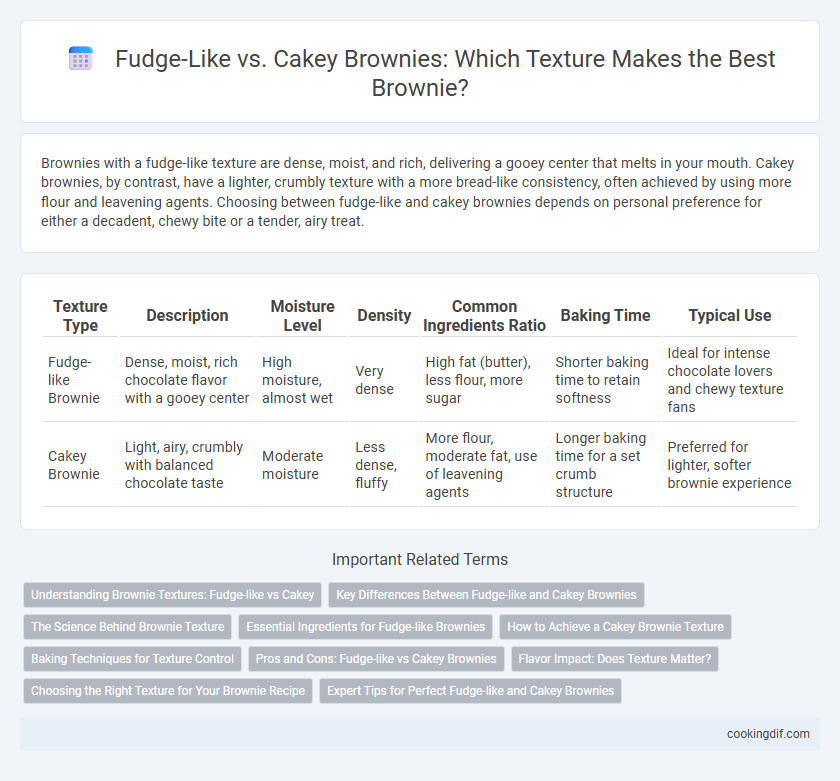Brownies with a fudge-like texture are dense, moist, and rich, delivering a gooey center that melts in your mouth. Cakey brownies, by contrast, have a lighter, crumbly texture with a more bread-like consistency, often achieved by using more flour and leavening agents. Choosing between fudge-like and cakey brownies depends on personal preference for either a decadent, chewy bite or a tender, airy treat.
Table of Comparison
| Texture Type | Description | Moisture Level | Density | Common Ingredients Ratio | Baking Time | Typical Use |
|---|---|---|---|---|---|---|
| Fudge-like Brownie | Dense, moist, rich chocolate flavor with a gooey center | High moisture, almost wet | Very dense | High fat (butter), less flour, more sugar | Shorter baking time to retain softness | Ideal for intense chocolate lovers and chewy texture fans |
| Cakey Brownie | Light, airy, crumbly with balanced chocolate taste | Moderate moisture | Less dense, fluffy | More flour, moderate fat, use of leavening agents | Longer baking time for a set crumb structure | Preferred for lighter, softer brownie experience |
Understanding Brownie Textures: Fudge-like vs Cakey
Fudge-like brownies are characterized by a dense, moist texture with a rich, gooey center, achieved by using a higher fat-to-flour ratio and minimal leavening agents. Cakey brownies have a lighter, airy crumb resulting from increased flour and baking powder or baking soda that incorporate more air during baking. Understanding these ingredient ratios and baking methods is key to mastering the desired brownie texture.
Key Differences Between Fudge-like and Cakey Brownies
Fudge-like brownies are dense, moist, and rich with a glossy, smooth surface, often achieved by using higher fat content and minimal flour. Cakey brownies have a lighter, airy texture resembling cake, with a more pronounced crumb structure due to increased flour and leavening agents. The key differences lie in moisture level, fat-to-flour ratio, and baking time, which influence the final chewiness and density of the brownies.
The Science Behind Brownie Texture
Brownie texture is largely determined by the ratio of fat, flour, and sugar, where higher fat content and less flour create a fudgy consistency due to fat's ability to inhibit gluten formation. Higher flour ratios and more leavening agents promote a cakey texture by encouraging gluten network formation and air incorporation during baking. The balance of ingredients controls moisture retention and crumb structure, making precise measurements crucial for achieving either the dense, chewy fudge-like brownie or the light, airy cakey variant.
Essential Ingredients for Fudge-like Brownies
Fudge-like brownies rely on a high fat-to-flour ratio, typically using more butter or oil and less flour to achieve a dense, moist texture. Essential ingredients include melted chocolate or cocoa powder combined with fats like butter, alongside eggs to create a rich, chewy consistency. Using less leavening agents, such as baking powder, helps maintain the fudgy density instead of a cakey crumb.
How to Achieve a Cakey Brownie Texture
Achieving a cakey brownie texture requires a higher ratio of flour to fat and the incorporation of baking powder or baking soda to provide lift and a lighter crumb. Beating the eggs well introduces air, contributing to structure and fluffiness, while avoiding overmixing prevents toughness. For moist yet tender cakey brownies, use a combination of oil and butter to balance richness with aeration.
Baking Techniques for Texture Control
Achieving a fudge-like brownie texture requires a high fat-to-flour ratio with minimal leavening agents, emphasizing dense, moist crumb structure through ingredients like melted butter and melted chocolate. Cakey brownies rely on more flour and baking powder or baking soda for lift, creating a lighter, airier texture by incorporating aeration through beaten eggs or creamed butter and sugar. Precise baking temperature and time control prevents dryness or undercooking, ensuring the desired texture consistency for either fudge-like or cakey brownies.
Pros and Cons: Fudge-like vs Cakey Brownies
Fudge-like brownies offer a dense, moist texture with intense chocolate flavor, ideal for rich, gooey indulgence but can feel heavy and overly sweet to some. Cakey brownies provide a lighter, airy crumb with a balanced sweetness and easier sliceability, though they may lack the depth and gooeyness of fudge varieties. Choosing between fudge-like and cakey brownies depends on personal preference for texture and flavor intensity, with fudge appealing to those craving decadence and cakey suited for a more traditional, less rich dessert.
Flavor Impact: Does Texture Matter?
Fudge-like brownies, characterized by their dense and moist texture, enhance the rich, chocolate flavor by concentrating cocoa intensity and providing a creamy mouthfeel that intensifies taste perception. Cakey brownies, with their lighter, airy crumb, offer a subtler chocolate experience but balance sweetness and texture, appealing to those who prefer a tender bite over richness. Texture significantly influences flavor impact, as the dense fudgy consistency holds more moisture and cocoa fat, amplifying chocolate notes compared to the cakey variation.
Choosing the Right Texture for Your Brownie Recipe
Fudge-like brownies offer a dense, moist texture characterized by a high fat-to-flour ratio and minimal leavening, perfect for a rich, chewy bite. Cakey brownies incorporate more flour and leavening agents like baking powder, resulting in a lighter, airy texture with a tender crumb. Selecting the right texture depends on personal preference and intended use, with fudge-like suited for indulgence and cakey preferred for a more traditional dessert experience.
Expert Tips for Perfect Fudge-like and Cakey Brownies
Expert tips for achieving the perfect fudge-like brownie texture emphasize using higher fat content with more butter or oil and reducing baking time to maintain moistness. For cakey brownies, incorporating extra flour and leavening agents like baking powder or baking soda creates a lighter, airier crumb, while longer baking at moderate temperatures ensures firm structure. Precise control over ingredient ratios and baking conditions distinguishes fudgy, dense brownies from those with a tender, cakey consistency.
Fudge-like vs Cakey for brownie texture Infographic

 cookingdif.com
cookingdif.com